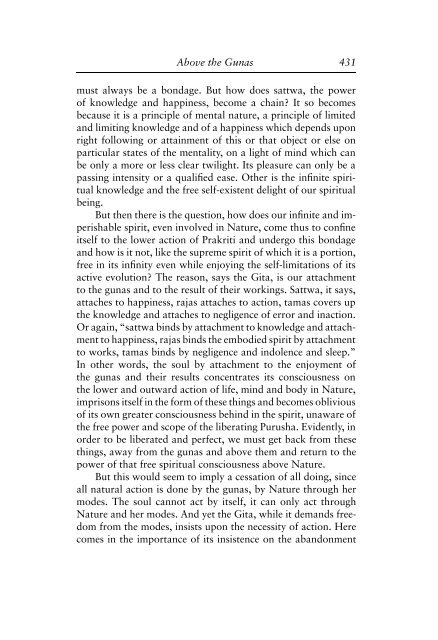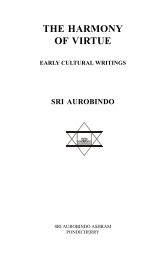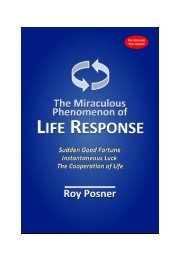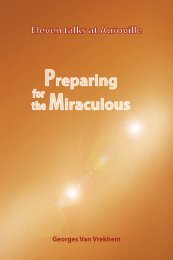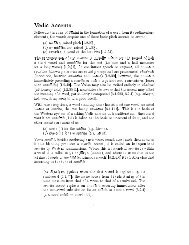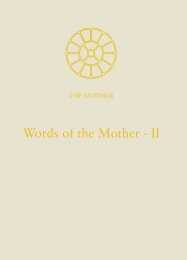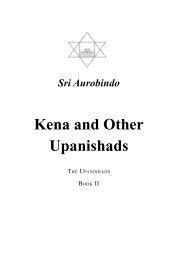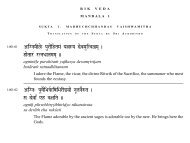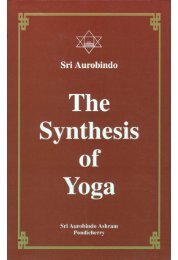- Page 2 and 3:
VOLUME 19THE COMPLETE WORKS OF SRI
- Page 5 and 6:
CONTENTSFIRST SERIESIOur Demand and
- Page 7:
CONTENTSIIIThe Supreme Divine 289IV
- Page 10 and 11:
A page of the Arya as revised by Sr
- Page 12 and 13:
4 Essays on the Gi
- Page 14 and 15:
6 Essays on the Gi
- Page 16 and 17:
8 Essays on the Gi
- Page 18 and 19:
10 Essays on the G
- Page 20 and 21:
IIThe Divine TeacherTHE PECULIARITY
- Page 22 and 23:
14 Essays on the G
- Page 24 and 25:
16 Essays on the G
- Page 26 and 27:
18 Essays on the G
- Page 28 and 29:
IIIThe Human DiscipleSUCH then is t
- Page 30 and 31:
22 Essays on the G
- Page 32 and 33:
24 Essays on the G
- Page 34 and 35:
26 Essays on the G
- Page 36 and 37:
28 Essays on the G
- Page 38 and 39:
30 Essays on the G
- Page 40 and 41:
32 Essays on the G
- Page 42 and 43:
34 Essays on the G
- Page 44 and 45:
36 Essays on the G
- Page 46 and 47:
38 Essays on the G
- Page 48 and 49:
40 Essays on the G
- Page 50 and 51:
42 Essays on the G
- Page 52 and 53:
44 Essays on the G
- Page 54 and 55:
46 Essays on the G
- Page 56 and 57:
48 Essays on the G
- Page 58 and 59:
50 Essays on the G
- Page 60 and 61:
52 Essays on the G
- Page 62 and 63:
54 Essays on the G
- Page 64 and 65:
56 Essays on the G
- Page 66 and 67:
58 Essays on the G
- Page 68 and 69:
60 Essays on the G
- Page 70 and 71:
62 Essays on the G
- Page 72 and 73:
64 Essays on the G
- Page 74 and 75:
66 Essays on the G
- Page 76 and 77:
VIIISankhya and YogaIN THE moment o
- Page 78 and 79:
70 Essays on the G
- Page 80 and 81:
72 Essays on the G
- Page 82 and 83:
74 Essays on the G
- Page 84 and 85:
76 Essays on the G
- Page 86 and 87:
78 Essays on the G
- Page 88 and 89:
80 Essays on the G
- Page 90 and 91:
82 Essays on the G
- Page 92 and 93:
84 Essays on the G
- Page 94 and 95:
86 Essays on the G
- Page 96 and 97:
88 Essays on the G
- Page 98 and 99:
90 Essays on the G
- Page 100 and 101:
92 Essays on the G
- Page 102 and 103:
XThe Yoga of the Intelligent WillIH
- Page 104 and 105:
96 Essays on the G
- Page 106 and 107:
98 Essays on the G
- Page 108 and 109:
100 Essays on the
- Page 110 and 111:
102 Essays on the
- Page 112 and 113:
104 Essays on the
- Page 114 and 115:
106 Essays on the
- Page 116 and 117:
108 Essays on the
- Page 118 and 119:
110 Essays on the
- Page 120 and 121:
112 Essays on the
- Page 122 and 123:
XIIThe Significance of SacrificeTHE
- Page 124 and 125:
116 Essays on the
- Page 126 and 127:
118 Essays on the
- Page 128 and 129:
120 Essays on the
- Page 130 and 131:
122 Essays on the
- Page 132 and 133:
XIIIThe Lord of the SacrificeWE HAV
- Page 134 and 135:
126 Essays on the
- Page 136 and 137:
128 Essays on the
- Page 138 and 139:
130 Essays on the
- Page 140 and 141:
132 Essays on the
- Page 142 and 143:
XIVThe Principle of Divine WorksTHI
- Page 144 and 145:
136 Essays on the
- Page 146 and 147:
138 Essays on the
- Page 148 and 149:
140 Essays on the
- Page 150 and 151:
142 Essays on the
- Page 152 and 153:
144 Essays on the
- Page 154 and 155:
146 Essays on the
- Page 156 and 157:
148 Essays on the
- Page 158 and 159:
150 Essays on the
- Page 160 and 161:
152 Essays on the
- Page 162 and 163:
154 Essays on the
- Page 164 and 165:
156 Essays on the
- Page 166 and 167:
XVIThe Process of AvatarhoodWE SEE
- Page 168 and 169:
160 Essays on the
- Page 170 and 171:
162 Essays on the
- Page 172 and 173:
164 Essays on the
- Page 174 and 175:
166 Essays on the
- Page 176 and 177:
XVIIThe Divine Birth and Divine Wor
- Page 178 and 179:
170 Essays on the
- Page 180 and 181:
172 Essays on the
- Page 182 and 183:
174 Essays on the
- Page 184 and 185:
176 Essays on the
- Page 186 and 187:
178 Essays on the
- Page 188 and 189:
180 Essays on the
- Page 190 and 191:
182 Essays on the
- Page 192 and 193:
184 Essays on the
- Page 194 and 195:
186 Essays on the
- Page 196 and 197:
XIXEqualitySINCE knowledge, desirel
- Page 198 and 199:
190 Essays on the
- Page 200 and 201:
192 Essays on the
- Page 202 and 203:
194 Essays on the
- Page 204 and 205:
196 Essays on the
- Page 206 and 207:
198 Essays on the
- Page 208 and 209:
XXEquality and KnowledgeYOGA and kn
- Page 210 and 211:
202 Essays on the
- Page 212 and 213:
204 Essays on the
- Page 214 and 215:
206 Essays on the
- Page 216 and 217:
208 Essays on the
- Page 218 and 219:
210 Essays on the
- Page 220 and 221:
XXIThe Determinism of NatureWHEN we
- Page 222 and 223:
214 Essays on the
- Page 224 and 225:
216 Essays on the
- Page 226 and 227:
218 Essays on the
- Page 228 and 229:
220 Essays on the
- Page 230 and 231:
222 Essays on the
- Page 232 and 233:
XXIIBeyond the Modes of NatureSO FA
- Page 234 and 235:
226 Essays on the
- Page 236 and 237:
228 Essays on the
- Page 238 and 239:
230 Essays on the
- Page 240 and 241:
232 Essays on the
- Page 242 and 243:
XXIIINirvana and Works in the World
- Page 244 and 245:
236 Essays on the
- Page 246 and 247:
238 Essays on the
- Page 248 and 249:
240 Essays on the
- Page 250 and 251:
242 Essays on the
- Page 252 and 253:
244 Essays on the
- Page 254 and 255:
246 Essays on the
- Page 256 and 257:
248 Essays on the
- Page 258 and 259:
250 Essays on the
- Page 260 and 261:
252 Essays on the
- Page 262 and 263:
254 Essays on the
- Page 264 and 265:
256 Essays on the
- Page 266 and 267:
258 Essays on the
- Page 269:
PART ITHE SYNTHESIS OF WORKS,LOVE A
- Page 272 and 273:
264 Essays on the
- Page 274 and 275:
266 Essays on the
- Page 276 and 277:
268 Essays on the
- Page 278 and 279:
270 Essays on the
- Page 280 and 281:
272 Essays on the
- Page 282 and 283:
274 Essays on the
- Page 284 and 285:
276 Essays on the
- Page 286 and 287:
IIThe Synthesis ofDevotion and Know
- Page 288 and 289:
280 Essays on the
- Page 290 and 291:
282 Essays on the
- Page 292 and 293:
284 Essays on the
- Page 294 and 295:
286 Essays on the
- Page 296 and 297:
288 Essays on the
- Page 298 and 299:
290 Essays on the
- Page 300 and 301:
292 Essays on the
- Page 302 and 303:
294 Essays on the
- Page 304 and 305:
296 Essays on the
- Page 306 and 307:
298 Essays on the
- Page 308 and 309:
300 Essays on the
- Page 310 and 311:
302 Essays on the
- Page 312 and 313:
304 Essays on the
- Page 314 and 315:
306 Essays on the
- Page 316 and 317:
308 Essays on the
- Page 318 and 319:
310 Essays on the
- Page 320 and 321:
312 Essays on the
- Page 322 and 323:
314 Essays on the
- Page 324 and 325:
316 Essays on the
- Page 326 and 327:
318 Essays on the
- Page 328 and 329:
320 Essays on the
- Page 330 and 331:
VIWorks, Devotion and KnowledgeTHIS
- Page 332 and 333:
324 Essays on the
- Page 334 and 335:
326 Essays on the
- Page 336 and 337:
328 Essays on the
- Page 338 and 339:
330 Essays on the
- Page 340 and 341:
332 Essays on the
- Page 342 and 343:
334 Essays on the
- Page 344 and 345:
336 Essays on the
- Page 346 and 347:
338 Essays on the
- Page 348 and 349:
340 Essays on the
- Page 350 and 351:
342 Essays on the
- Page 352 and 353:
344 Essays on the
- Page 354 and 355:
346 Essays on the
- Page 356 and 357:
348 Essays on the
- Page 358 and 359:
350 Essays on the
- Page 360 and 361:
352 Essays on the
- Page 362 and 363:
354 Essays on the
- Page 364 and 365:
356 Essays on the
- Page 366 and 367:
358 Essays on the
- Page 368 and 369:
360 Essays on the
- Page 370 and 371:
362 Essays on the
- Page 372 and 373:
364 Essays on the
- Page 374 and 375:
IXThe Theory of the VibhutiTHE IMPO
- Page 376 and 377:
368 Essays on the
- Page 378 and 379:
370 Essays on the
- Page 380 and 381:
372 Essays on the
- Page 382 and 383:
374 Essays on the
- Page 384 and 385:
376 Essays on the
- Page 386 and 387:
378 Essays on the
- Page 388 and 389: 380 Essays on the
- Page 390 and 391: 382 Essays on the
- Page 392 and 393: 384 Essays on the
- Page 394 and 395: 386 Essays on the
- Page 396 and 397: XIThe Vision of the World-Spirit 1T
- Page 398 and 399: 390 Essays on the
- Page 400 and 401: 392 Essays on the
- Page 402 and 403: 394 Essays on the
- Page 404 and 405: XIIThe Way and the BhaktaIN THE ele
- Page 406 and 407: 398 Essays on the
- Page 408 and 409: 400 Essays on the
- Page 410 and 411: 402 Essays on the
- Page 412 and 413: 404 Essays on the
- Page 414 and 415: 406 Essays on the
- Page 417 and 418: XIIIThe Field and its Knower 1THE G
- Page 419 and 420: The Field and its Knower 411reality
- Page 421 and 422: The Field and its Knower 413field o
- Page 423 and 424: The Field and its Knower 415and ste
- Page 425 and 426: The Field and its Knower 417his own
- Page 427 and 428: The Field and its Knower 419urging
- Page 429 and 430: XIVAbove the Gunas 1THE DISTINCTION
- Page 431 and 432: Above the Gunas 423put on the law o
- Page 433 and 434: Above the Gunas 425from which it pr
- Page 435 and 436: Above the Gunas 427glimpse of it in
- Page 437: Above the Gunas 429— when the int
- Page 441 and 442: Above the Gunas 433and the faction
- Page 443 and 444: XVThe Three Purushas 1THE DOCTRINE
- Page 445 and 446: The Three Purushas 437to being, fro
- Page 447 and 448: The Three Purushas 439and however p
- Page 449 and 450: The Three Purushas 441dhāma. Still
- Page 451 and 452: The Three Purushas 443in this other
- Page 453 and 454: The Three Purushas 445lokasaṅgrah
- Page 455 and 456: The Three Purushas 447the light of
- Page 457 and 458: The Three Purushas 449be perfected
- Page 459 and 460: The Fullness of Spiritual Action 45
- Page 461 and 462: The Fullness of Spiritual Action 45
- Page 463 and 464: The Fullness of Spiritual Action 45
- Page 465 and 466: The Fullness of Spiritual Action 45
- Page 467 and 468: The Fullness of Spiritual Action 45
- Page 469 and 470: The Fullness of Spiritual Action 46
- Page 471 and 472: XVIIDeva and Asura 1THE PRACTICAL d
- Page 473 and 474: Deva and Asura 465will of the spiri
- Page 475 and 476: Deva and Asura 467of widest self-ex
- Page 477 and 478: Deva and Asura 469the necessity of
- Page 479 and 480: Deva and Asura 471the Master of the
- Page 481 and 482: Deva and Asura 473shall have that o
- Page 483 and 484: Deva and Asura 475status. To follow
- Page 485 and 486: XVIIIThe Gunas, Faith and Works 1TH
- Page 487 and 488: The Gunas, Faith and Works 479convi
- Page 489 and 490:
The Gunas, Faith and Works 481to hi
- Page 491 and 492:
The Gunas, Faith and Works 483inexp
- Page 493 and 494:
The Gunas, Faith and Works 485is wh
- Page 495 and 496:
The Gunas, Faith and Works 487direc
- Page 497 and 498:
The Gunas, Faith and Works 489and h
- Page 499 and 500:
The Gunas, Faith and Works 491The c
- Page 501 and 502:
XIXThe Gunas, Mind and Works 1THE G
- Page 503 and 504:
The Gunas, Mind and Works 495of us.
- Page 505 and 506:
The Gunas, Mind and Works 497karma.
- Page 507 and 508:
The Gunas, Mind and Works 499the un
- Page 509 and 510:
The Gunas, Mind and Works 501ignora
- Page 511 and 512:
The Gunas, Mind and Works 503choose
- Page 513 and 514:
The Gunas, Mind and Works 505with t
- Page 515 and 516:
XXSwabhava and Swadharma 1IT IS the
- Page 517 and 518:
Swabhava and Swadharma 509function
- Page 519 and 520:
Swabhava and Swadharma 511actually
- Page 521 and 522:
Swabhava and Swadharma 513of every
- Page 523 and 524:
Swabhava and Swadharma 515a man’s
- Page 525 and 526:
Swabhava and Swadharma 517immediate
- Page 527 and 528:
Swabhava and Swadharma 519will disc
- Page 529 and 530:
Swabhava and Swadharma 521acts, but
- Page 531 and 532:
Swabhava and Swadharma 523times hav
- Page 533 and 534:
Swabhava and Swadharma 525Swabhava.
- Page 535 and 536:
Towards the Supreme Secret 527and f
- Page 537 and 538:
Towards the Supreme Secret 529absor
- Page 539 and 540:
Towards the Supreme Secret 531not p
- Page 541 and 542:
Towards the Supreme Secret 533Impri
- Page 543 and 544:
Towards the Supreme Secret 535all m
- Page 545 and 546:
Towards the Supreme Secret 537devot
- Page 547 and 548:
Towards the Supreme Secret 539beyon
- Page 549 and 550:
The Supreme Secret 541in thy egoism
- Page 551 and 552:
The Supreme Secret 543it is a truth
- Page 553 and 554:
The Supreme Secret 545of these thin
- Page 555 and 556:
The Supreme Secret 547That reconcil
- Page 557 and 558:
The Supreme Secret 549must be broke
- Page 559 and 560:
The Supreme Secret 551luminosities
- Page 561 and 562:
The Supreme Secret 553godhead there
- Page 563 and 564:
The Supreme Secret 555of every crea
- Page 565 and 566:
The Supreme Secret 557“All this p
- Page 567 and 568:
The Supreme Secret 559sorrow and th
- Page 569 and 570:
The Supreme Secret 561will overtly
- Page 571 and 572:
The Core of the Gita’s Meaning 56
- Page 573 and 574:
The Core of the Gita’s Meaning 56
- Page 575 and 576:
The Core of the Gita’s Meaning 56
- Page 577 and 578:
The Core of the Gita’s Meaning 56
- Page 579 and 580:
The Core of the Gita’s Meaning 57
- Page 581 and 582:
The Message of the Gita 573Here it
- Page 583 and 584:
The Message of the Gita 575And our
- Page 585 and 586:
The Message of the Gita 577your sou
- Page 587 and 588:
The Message of the Gita 579Power in
- Page 589 and 590:
The Message of the Gita 581but it i
- Page 591 and 592:
The Message of the Gita 583down the
- Page 593 and 594:
The Message of the Gita 585the pure
- Page 595 and 596:
The Message of the Gita 587your lab
- Page 597 and 598:
The Message of the Gita 589all the
- Page 599 and 600:
The Message of the Gita 591physical
- Page 601 and 602:
The Message of the Gita 593ignoranc
- Page 603:
Note on the TextESSAYS ON THE GITA


